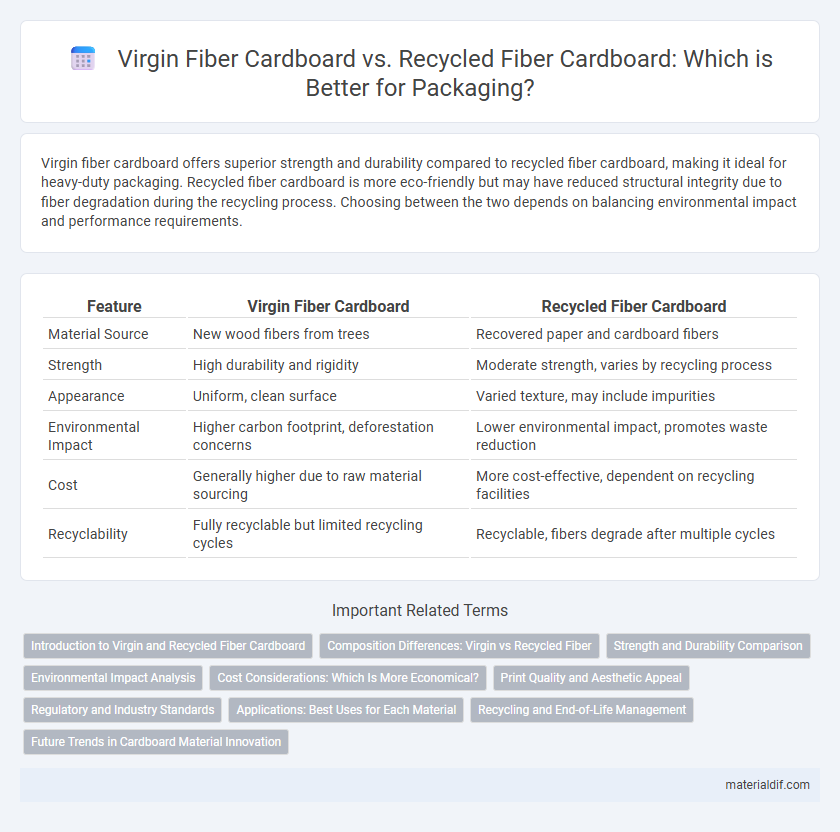Virgin fiber cardboard offers superior strength and durability compared to recycled fiber cardboard, making it ideal for heavy-duty packaging. Recycled fiber cardboard is more eco-friendly but may have reduced structural integrity due to fiber degradation during the recycling process. Choosing between the two depends on balancing environmental impact and performance requirements.
Table of Comparison
| Feature | Virgin Fiber Cardboard | Recycled Fiber Cardboard |
|---|---|---|
| Material Source | New wood fibers from trees | Recovered paper and cardboard fibers |
| Strength | High durability and rigidity | Moderate strength, varies by recycling process |
| Appearance | Uniform, clean surface | Varied texture, may include impurities |
| Environmental Impact | Higher carbon footprint, deforestation concerns | Lower environmental impact, promotes waste reduction |
| Cost | Generally higher due to raw material sourcing | More cost-effective, dependent on recycling facilities |
| Recyclability | Fully recyclable but limited recycling cycles | Recyclable, fibers degrade after multiple cycles |
Introduction to Virgin and Recycled Fiber Cardboard
Virgin fiber cardboard is produced directly from fresh wood pulp, offering superior strength, brightness, and uniformity, making it ideal for packaging requiring high durability and premium appearance. Recycled fiber cardboard is manufactured using recovered paper fibers, significantly reducing environmental impact by conserving natural resources and lowering energy consumption. While recycled fiber cardboard may have slightly reduced strength and color consistency, advancements in recycling technology have improved its quality, making it a sustainable choice for many packaging applications.
Composition Differences: Virgin vs Recycled Fiber
Virgin fiber cardboard is composed entirely of new pulp derived directly from wood, resulting in stronger, more durable sheets with higher structural integrity. Recycled fiber cardboard incorporates previously used fibers, which often contain shorter and weaker fibers due to processing, leading to reduced strength and stiffness compared to virgin fiber counterparts. The mixture of virgin and recycled fibers in some cardboard products balances sustainability with performance by enhancing fiber bonding while minimizing environmental impact.
Strength and Durability Comparison
Virgin fiber cardboard offers superior strength and durability due to its long, intact fibers, providing better resistance to tearing and crushing compared to recycled fiber cardboard. Recycled fiber cardboard contains shorter, weaker fibers resulting from previous processing, which compromises its structural integrity and load-bearing capacity. For packaging applications requiring high strength and durability, virgin fiber cardboard is typically preferred despite higher material costs.
Environmental Impact Analysis
Virgin fiber cardboard generates higher carbon emissions and consumes more water compared to recycled fiber cardboard, contributing significantly to deforestation and habitat loss. Recycled fiber cardboard reduces landfill waste by reusing materials, lowers energy consumption by up to 60%, and decreases greenhouse gas emissions throughout production. Life cycle assessments consistently show recycled fiber cardboard has a smaller environmental footprint, promoting sustainable resource management and circular economy principles.
Cost Considerations: Which Is More Economical?
Virgin fiber cardboard typically incurs higher production costs due to the use of fresh wood pulp, resulting in a more expensive raw material base compared to recycled fiber cardboard. Recycled fiber cardboard benefits from lower material costs and reduced energy consumption during manufacturing, making it a more economical choice for businesses aiming to minimize expenses. Cost considerations often favor recycled fiber cardboard in large-scale packaging operations where budget constraints and sustainability goals align.
Print Quality and Aesthetic Appeal
Virgin fiber cardboard offers superior print quality and aesthetic appeal due to its smooth surface and consistent texture, enabling sharper images and vibrant colors. Recycled fiber cardboard, while more environmentally friendly, often has a rougher texture that can result in muted print colors and less precise detailing. Brands prioritizing premium packaging typically choose virgin fiber for its enhanced visual impact and durability.
Regulatory and Industry Standards
Virgin fiber cardboard complies with stringent regulatory and industry standards such as FSC certification and ASTM D6868, ensuring high-quality, sustainable sourcing and superior strength. Recycled fiber cardboard often meets EPA guidelines and relevant ISO standards but may face limitations in critical load-bearing applications due to fiber degradation. Both types require adherence to local environmental regulations, with recycled fiber promoting circular economy goals while virgin fiber focuses on performance metrics.
Applications: Best Uses for Each Material
Virgin fiber cardboard is ideal for high-quality packaging requiring strength, durability, and a pristine appearance, such as luxury product boxes and food packaging where contamination prevention is critical. Recycled fiber cardboard suits eco-friendly applications like shipping cartons, storage boxes, and secondary packaging where sustainability and cost are prioritized over aesthetic perfection. Choosing between virgin and recycled fiber depends on balancing performance requirements with environmental impact in applications ranging from retail display to industrial shipping.
Recycling and End-of-Life Management
Virgin fiber cardboard offers superior strength and durability but requires more energy and natural resources for production, contributing to a larger environmental footprint. Recycled fiber cardboard significantly reduces waste by reusing post-consumer materials and requires less energy, making it a more sustainable option for recycling and end-of-life management. Effective recycling programs enhance the lifespan of recycled fiber cardboard, promoting circular economy principles and reducing landfill dependency.
Future Trends in Cardboard Material Innovation
Virgin fiber cardboard maintains superior strength and durability, making it ideal for high-quality packaging applications, while recycled fiber cardboard emphasizes sustainability and cost-efficiency by reducing environmental impact. Future trends in cardboard material innovation focus on enhancing the recyclability and biodegradability of fibers, integrating bio-based additives and nanocellulose to improve mechanical properties without compromising eco-friendliness. Advanced fiber processing technologies aim to balance performance with circular economy goals, driving the evolution toward more sustainable yet robust cardboard solutions.
Virgin fiber cardboard vs Recycled fiber cardboard Infographic

 materialdif.com
materialdif.com